1996 CADILLAC FLEETWOOD check engine
[x] Cancel search: check enginePage 125 of 306
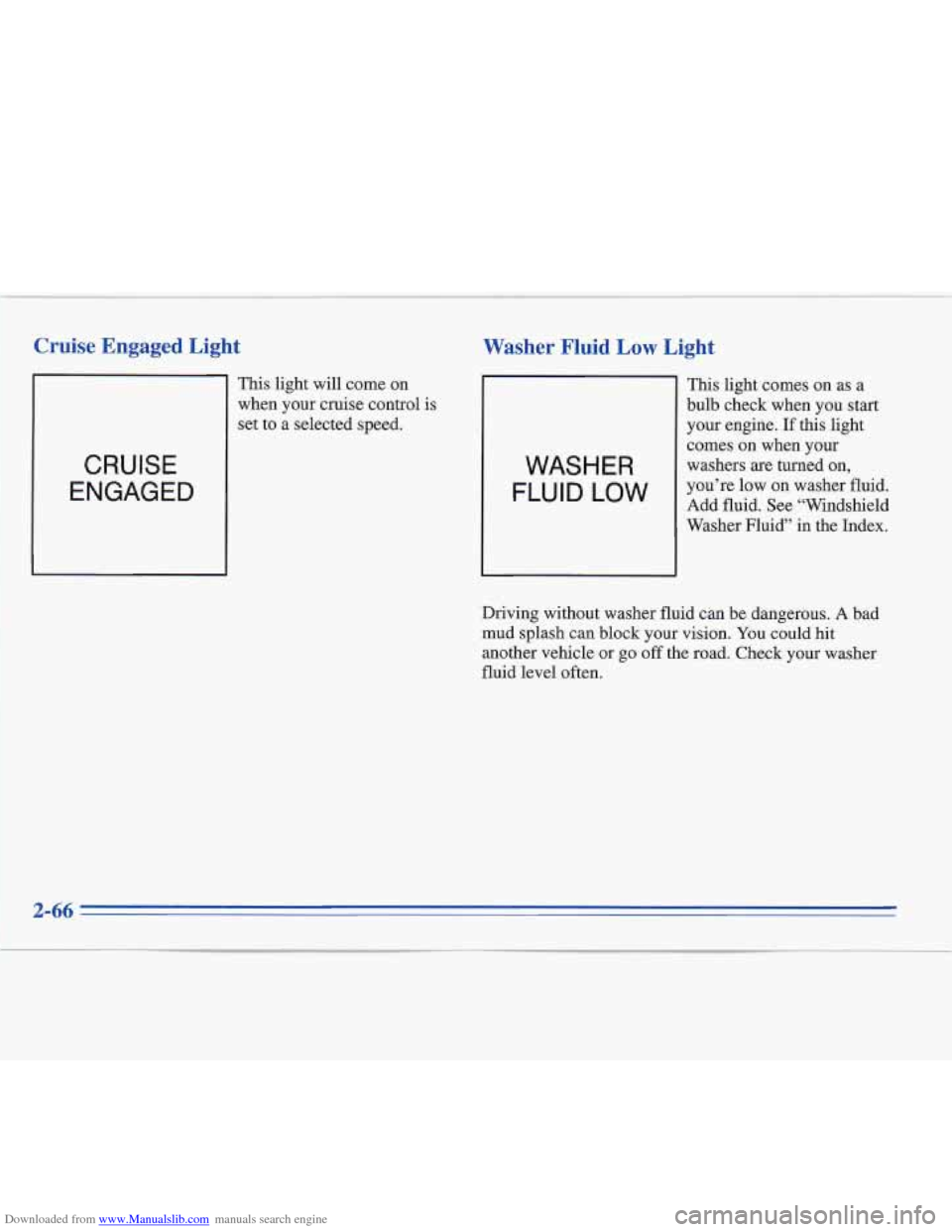
Downloaded from www.Manualslib.com manuals search engine Cruise Engaged Light
This light will come on
when your cruise control is
set to a selected speed.
CRUISE
ENGAGED
Washer Fluid Low Light
WASHER
FLUID LOW
This
bulb light comes
on as a
check when you start
your engine.
If this light
comes on when your
washers
are turned on,
you're low on washer fluid.
Add fluid. See "Windshield
Washer
Fluid" in the Index.
Driving without washer fluid can be dangerous.
A bad
mud splash can block your vision.
You could hit
another vehicle or go off the road. Check your washer
fluid level often.
Page 143 of 306
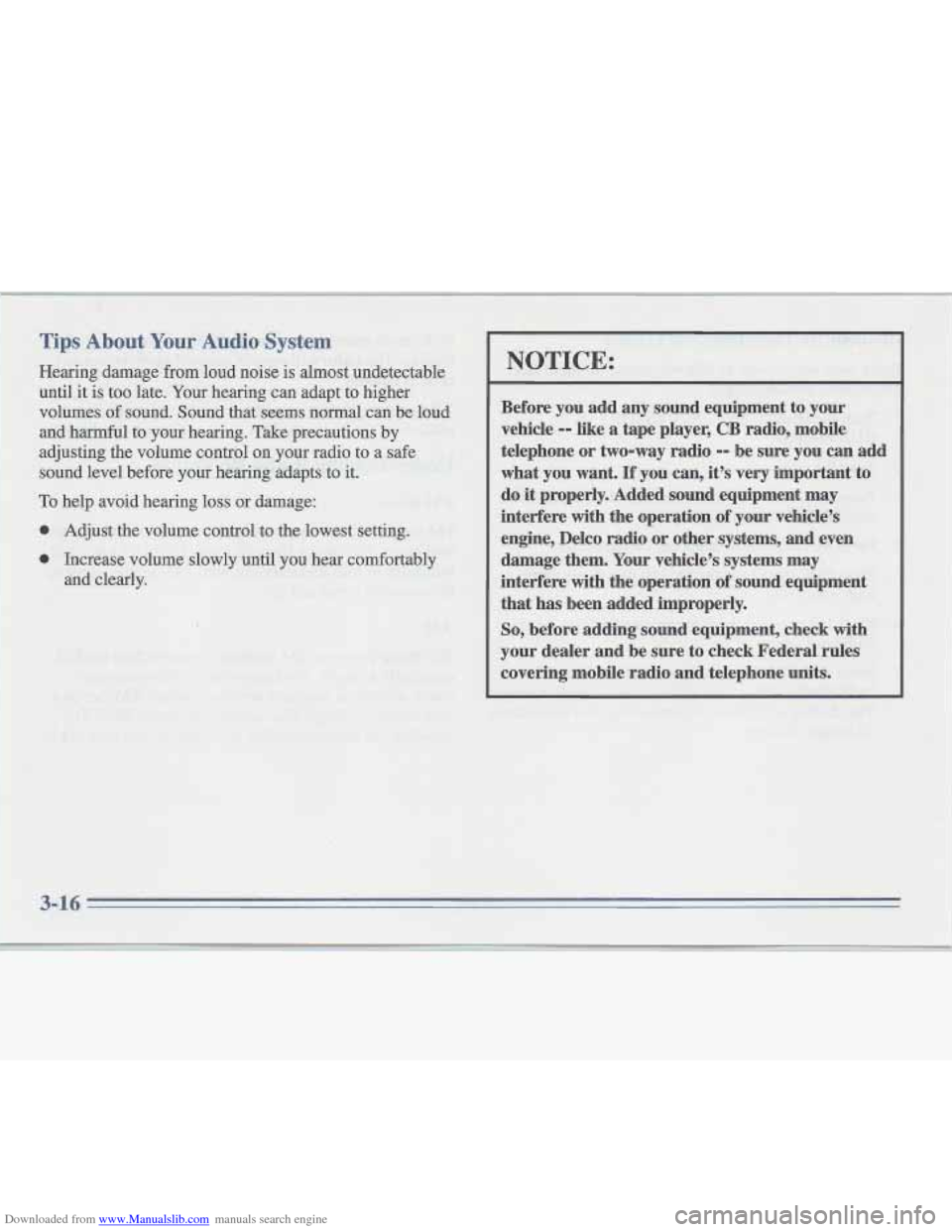
Downloaded from www.Manualslib.com manuals search engine NOTICE:
Before you add any sound equipment to your
vehicle
-- like a tape player, CB radio, mobile
telephone or two-way radio
-- be sure you can add
what you want.
If you can, it’s very important to
do
it properly. Added sound equipment may
interfere with the operation of your vehicle’s
engine, Delco radio or other systems, and even
damage them. Your vehicle’s systems may
interfere with the operation
of sound equipment
that has been added improperly.
So, before adding sound equipment, check with
your dealer and be sure to check Federal rules
covering mobile radio and telephone units.
Page 151 of 306
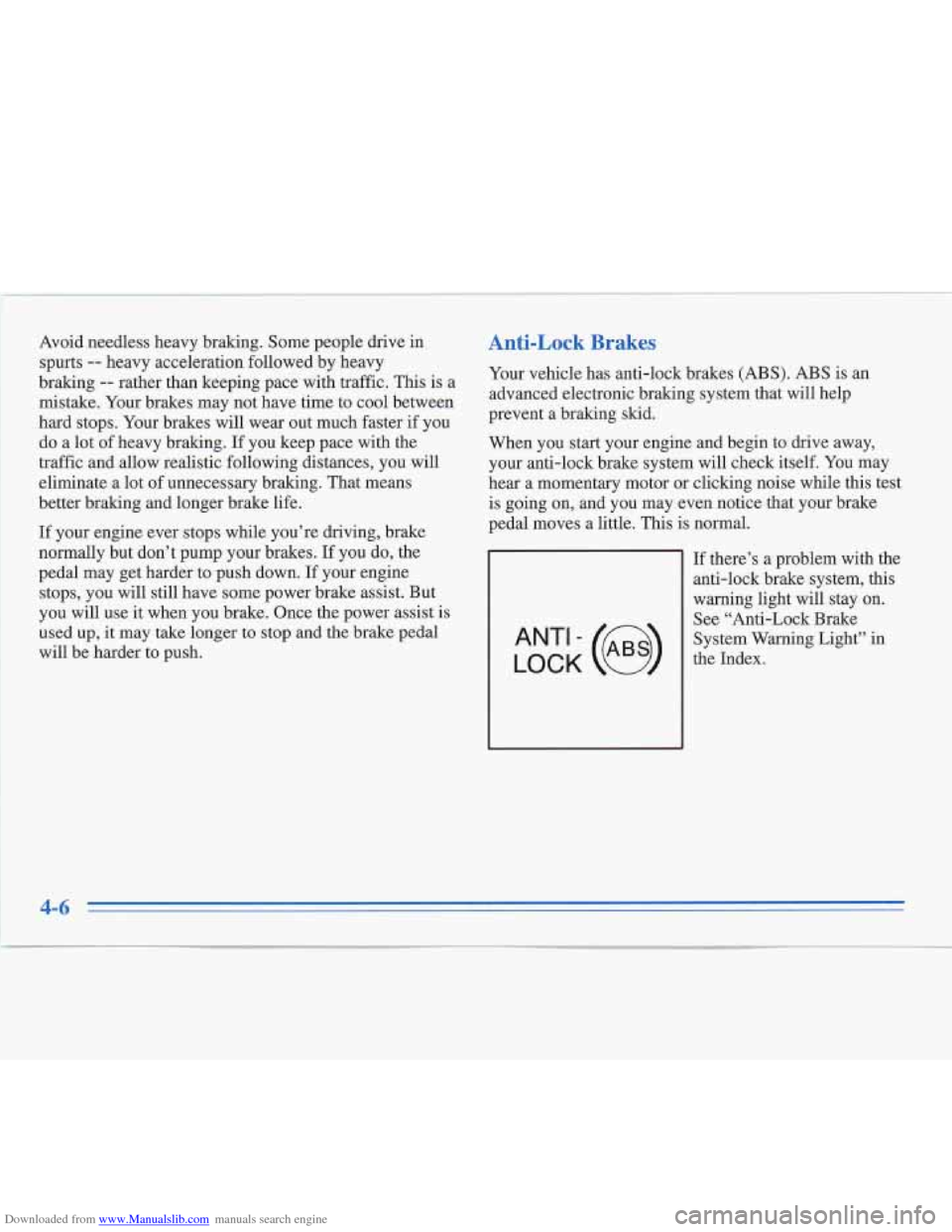
Downloaded from www.Manualslib.com manuals search engine Avoid needless heavy braking. Some people drive in
spurts
-- heavy acceleration followed by heavy
braking
-- rather than keeping pace with traffic. This is a
mistake. Your brakes may not have time to cool between
hard stops. Your brakes will wear out much faster if you
do a lot of heavy braking. If you keep pace with the
traffic and allow realistic following distances, you will
eliminate a lot of unnecessary braking. That means
better braking and longer brake life.
If your engine ever stops while you’re driving, brake
normally but don’t pump your brakes. If you do, the
pedal may get harder to push down.
If your engine
stops, you will still have some power brake assist. But
you will use it when you brake. Once the power assist is
used up,
it may take longer to stop and the brake pedal
will be harder to push.
Anti-Lock Brakes
Your vehicle has anti-lock brakes (ABS). ABS is an
advanced electronic braking system that will help
prevent a braking skid.
When you start your engine and begin to drive away,
your anti-lock brake system will check itself. You may
hear a momentary motor or clicking noise while this test
is going on, and you may even notice that your brake
pedal moves a little. This is normal.
LOCK
ANT‘- (e)
If there’s a problem with the
anti-lock brake system, this
warning light will stay on. See “Anti-Lock Brake
System Warning Light’’ in
the Index.
4-6
Page 158 of 306
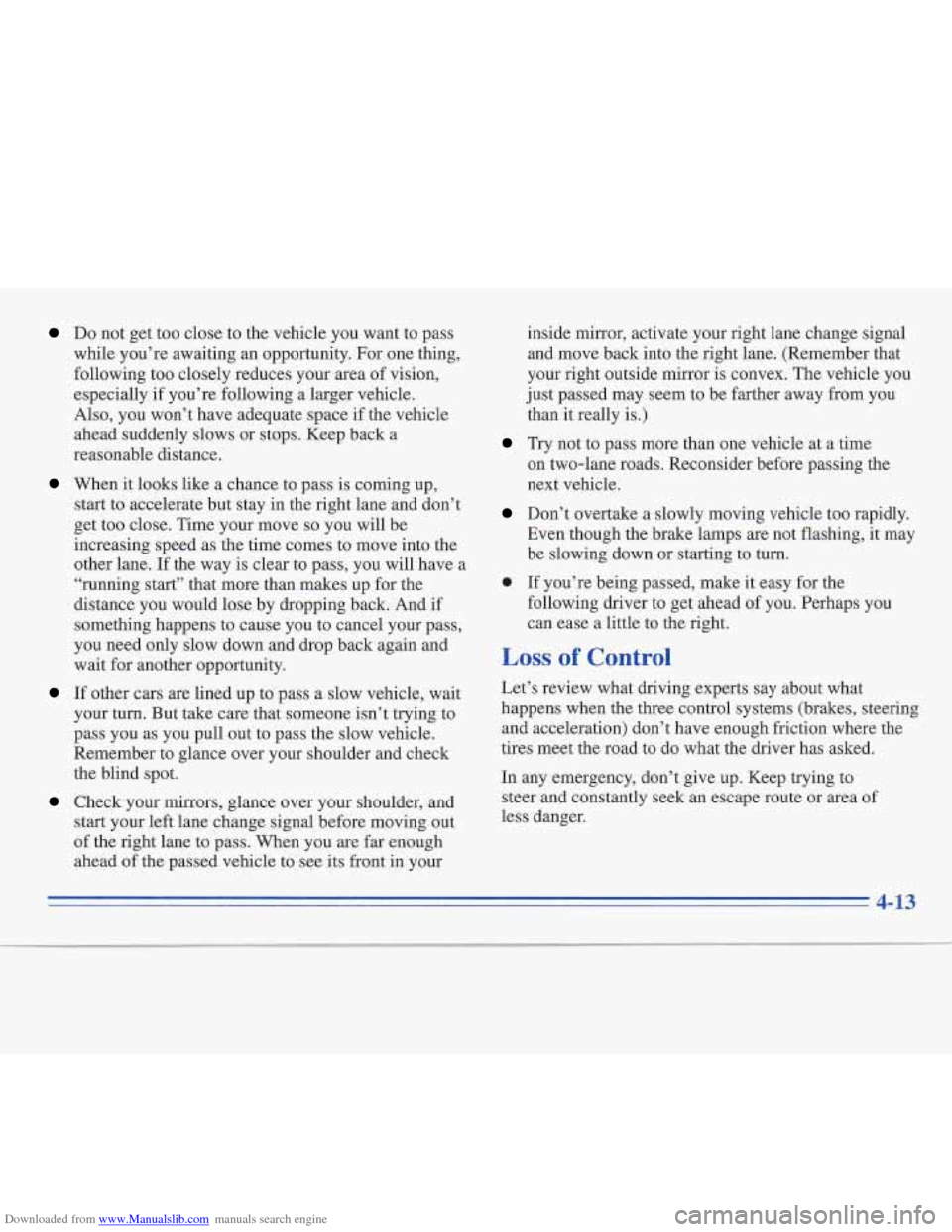
Downloaded from www.Manualslib.com manuals search engine Do not get too close to the vehicle you want to pass
while you’re awaiting an opportunity. For one thing,
following too closely reduces your area of vision,
especially if you’re following a larger vehicle.
Also, you won’t have adequate space if the vehicle
ahead suddenly slows or stops. Keep back a
reasonable distance.
When it looks like a chance to pass is coming up,
start to accelerate but stay in the right lane and don’t
get too close. Time your move
so you will be
increasing speed as the time comes to move into the
other lane.
If the way is clear to pass, you will have a
“running start” that more than makes up for the
distance you would lose by dropping back. And if
something happens to cause you to cancel your pass,
you need only slow down and drop back again and
wait for another opportunity.
If other cars are lined up to pass a slow vehicle, wait
your turn. But take care that someone isn’t trying to
pass you as you pull out to pass the slow vehicle.
Remember to glance over your shoulder and check
the blind spot.
Check your mirrors, glance over your shoulder, and
start your left lane change signal before moving out
of the right lane to pass. When you are far enough
ahead of the passed vehicle to see its front in your inside
mirror, activate your right lane change signal
and move back into the right lane. (Remember that
your right outside mirror
is convex. The vehicle you
just passed may seem to be farther away from you
than it really is.)
Try not to pass more than one vehicle at a time
on two-lane roads. Reconsider before passing the
next vehicle.
Don’t overtake a slowly moving vehicle too rapidly.
Even though the brake lamps are not flashing, it may
be slowing down or starting to turn.
0 If you’re being passed, make it easy for the
following driver to get ahead of you. Perhaps you
can ease a little to the right.
Loss of Control
Let’s review what driving experts say about what
happens when the
three control systems (brakes, steering
and acceleration) don’t have enough friction where the
tires meet the road to do what the driver has asked.
In any emergency, don’t give up. Keep trying to
steer and constantly seek an escape route or area
of
less danger.
4-13
Page 165 of 306
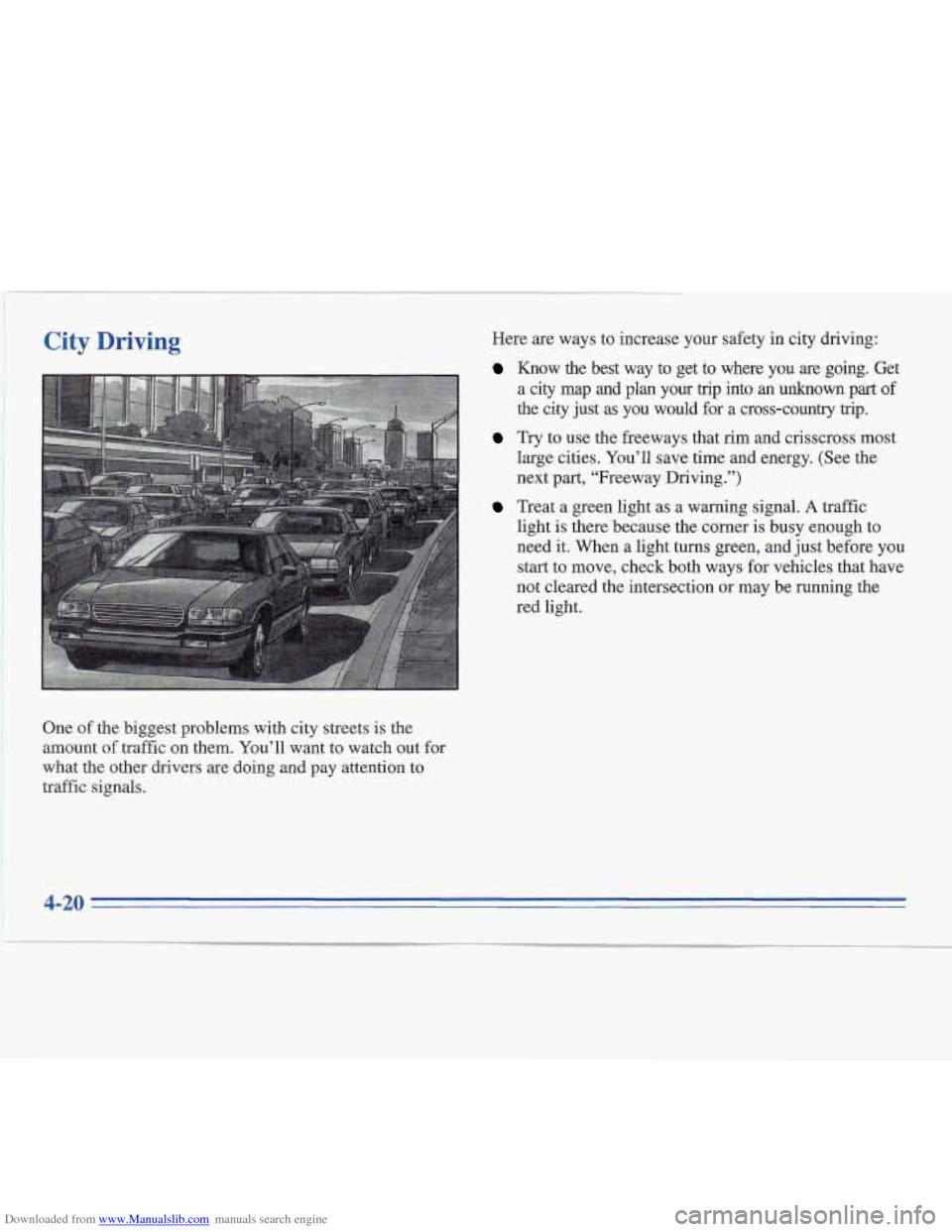
Downloaded from www.Manualslib.com manuals search engine City Driving
. ,,- Here are ways to increase your safety in city driving:
Know the best way to get to where you are going. Get
a city map and plan your trip into an unknown part of
the city just as you would for a cross-country trip.
Try to use the freeways that rim and crisscross most
large cities. You’ll save time and energy. (See the
next part, “Freeway Driving.”)
light is there because the corner
is busy enough to
need it. When a light turns green, and just before you
start to move, check both ways for vehicles that have
not cleared
the intersection or may be running the
red light.
Treat a green light as a warning signal. A traffic
One of the biggest problems with city streets
is the
amount
of traffic on them. You’ll want to watch out for
what the other drivers
are doing and pay attention to
traffic signals.
4-20
Page 166 of 306

Downloaded from www.Manualslib.com manuals search engine Freeway Driving
Mile for mile, freeways (also called thruways, parkways,
expressways, turnpikes or superhighways)
are the safest
of all roads. But they have their own special rules.
The most important advice
on freeway driving is: Keep
up with traffic and keep to the right. Drive at the same
speed most of the other drivers are driving. Too-fast or
too-slow driving breaks a smooth traffic flow. Treat the
left lane on a freeway as a passing lane. At the entrance, there
is usually a ramp that leads to the
freeway. If you have a clear view of the freeway as you
drive along the entrance ramp, you should begin to
check traffic. Try to determine where you expect to
blend with the
flow. Try to merge into the gap at close to
the prevailing speed. Switch on your turn signal, check
your mirrors and glance over your shoulder as often as
necessary. Try to blend smoothly with the traffic flow.
Once you are on the freeway, adjust your speed to the
posted limit or to the prevailing rate if it’s slower. Stay
in the right lane unless you want to pass.
Before changing lanes, check your mirrors. Then use
your turn signal.
Just before you leave the lane, glance quickly over your
shoulder to make sure there isn’t another vehicle in your
“blind” spot.
Once you are moving on the freeway, make certain you
allow a reasonable following distance. Expect to move
slightly slower at night.
When you want to leave the freeway, move to the proper
lane well in advance.
If you miss your exit, do not,
under any circumstances, stop and back up. Drive on to
the next exit.
The exit ramp can be curved, sometimes quite sharply.
4-21
Page 168 of 306
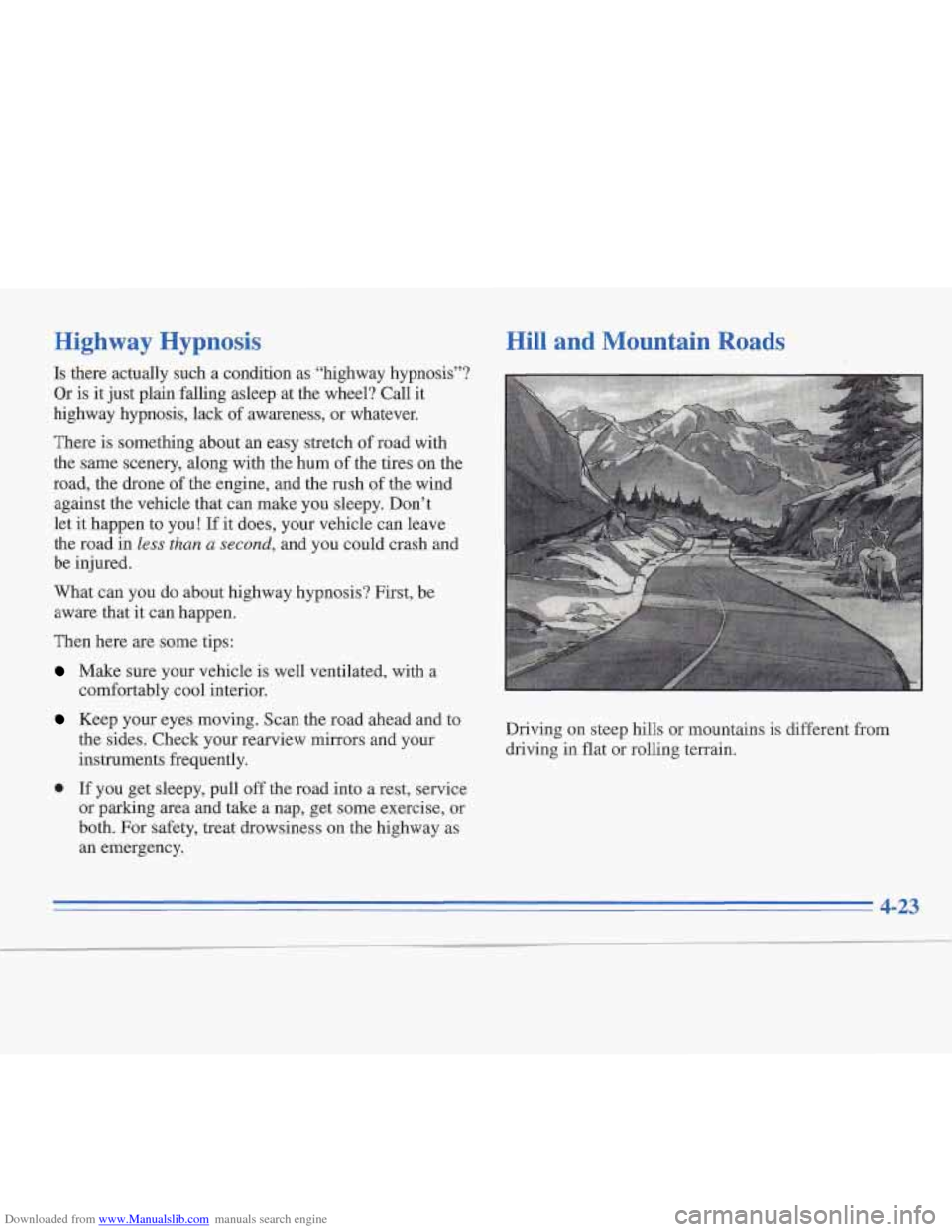
Downloaded from www.Manualslib.com manuals search engine Highway Hypnosis
Is there actually such a condition as “highway hypnosis”?
Or is it just plain falling asleep at the wheel? Call it
highway hypnosis, lack of awareness, or whatever.
There is something about an easy stretch
of road with
the same scenery, along with the hum of the tires on the
road, the drone of the engine, and the rush of the wind
against the vehicle that can make you sleepy. Don’t
let it happen to you! If it does, your vehicle can leave
the road in
less than a second, and you could crash and
be injured.
What can you do about highway hypnosis? First, be
aware that it can happen.
Then here are some tips:
Make sure your vehicle is well ventilated, with a
comfortably cool interior.
Keep your eyes moving. Scan the road ahead and to
the sides. Check your rearview mirrors and your
instruments frequently.
0 If you get sleepy, pull off the road into a rest, service
or parking area and take a nap, get some exercise, or
both. For safety, treat drowsiness on the highway as
an emergency.
Hill and Mountain Roads
Driving on steep hills or mountains is different from
driving in flat
or rolling terrain.
4-23
Page 181 of 306
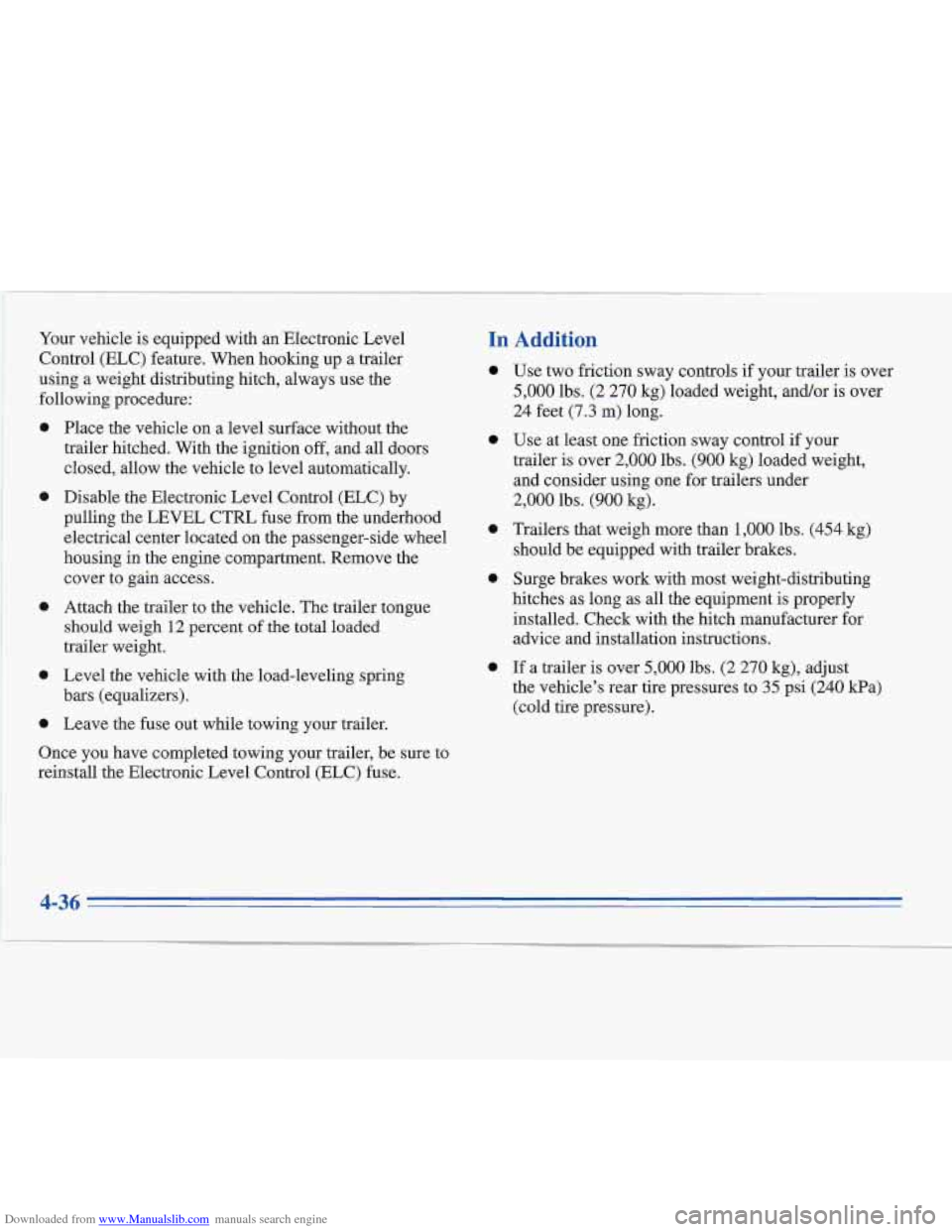
Downloaded from www.Manualslib.com manuals search engine Your vehicle is equipped with an Electronic Level
Control (ELC) feature. When hooking up a trailer
using a weight distributing hitch, always use the
following procedure:
a
a
a
a
0
Place the vehicle on a level surface without the
trailer hitched. With the ignition off, and all doors
closed, allow the vehicle to level automatically.
Disable the Electronic Level Control (ELC) by
pulling the LEVEL CTRL fuse from the underhood
electrical center located on the passenger-side wheel
housing in the engine compartment. Remove the
cover to gain access.
Attach the trailer to the vehicle. The trailer tongue
should weigh
12 percent of the total loaded
trailer weight.
Level the vehicle with the load-leveling spring
bars (equalizers).
Leave the fuse out while towing your trailer.
Once you have completed towing your trailer, be sure
to
reinstall the Electronic Level Control (ELC) fuse.
In Addlon
a
a
a
0
0
Use two friction sway controls if your trailer is over
5,000 lbs. (2 270 kg) loaded weight, and/or is over
24 feet (7.3 m) long.
Use at least one friction sway control if your
trailer is over
2,000 lbs. (900 kg) loaded weight,
and consider using one for trailers under
2,000 lbs.
(900 kg).
Trailers that weigh more than
1,000 lbs. (454 kg)
should be equipped with trailer brakes.
Surge brakes work with most weight-distributing
hitches as long as all the equipment is properly
installed. Check with the hitch manufacturer for
advice and installation instructions.
If a trailer is over 5,000 lbs. (2 270 kg), adjust
the vehicle's rear tire pressures to
35 psi (240 Pa)
(cold tire pressure).
4-36